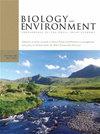The Gunnera: Nostoc Symbiosis
IF 0.6
4区 环境科学与生态学
Q4 ENVIRONMENTAL SCIENCES
Biology and Environment-Proceedings of the Royal Irish Academy
Pub Date : 2022-01-01
DOI:10.3318/BIOE.2002.102.1.35
引用次数: 20
Abstract
Among angiosperms, a restricted number of plants are capable of forming symbioses with nitrogen fixing organisms. The best-studied examples of symbiosis are those between legumninous plants and nitrogen-fixing rhizobia. Although cyanobacteria are the most potent nitrogen-fixing microsymbionts in terms of variations in the taxonomy of the hosts, ranging from fungi to higher plants, extant cyanobacterial symbioses encompass only one an giosperm family. This monogeneric family, the Gunneraceae, has an unclear taxonomic affiliation. It comprises about 50 species, which show great variation in size. The larger, rhubarb-like, stand forming species (up to 6m high) are typical of areas ranging from Hawaii to Central America and South America, whereas smaHer, more slender species are found in New Zealand, South-East Asia and the southernmost parts of South America. The eleven endemic species of New Zealand are all small, often < 10cm high, and form stolons, whereas the larger species are rhizomatous. The natural distribution of Gunnera is restricted to the southern hemisphere, but naturalised Gunnera (G. tinctoria) is now known from some European sites, for instance the west coast of Ireland, south-western England, northern France and the Azores. A characteristic of all Gunnera species is their preference for wet and humid areas. Ever since cyanobacteria were discovered in side cells of Gunnera at the end of the nineteenth century, they have been classified as belonging to the genus Nostoc. This is a widespread and globally common filamentous genus capable of advanced cell differentiation. Under nitrogen limitation, het erocysts (sites for the nitrogen-fixing enzyme intro genase) are formed, constituting 5-10% of the total cell population, whereas other adverse conditions may give rise to motile hormogonia or resting spores (akinetes). The differentiation of hormogo nia (the de facto infection units in symbioses) and heterocysts is crucial to the formation of the Gunnera symbioses. Although possibly restricted to the genus Nostoc, several species and strains are capable of forming symbioses with Gunnera, including those compatible with plants such as liverworts and cycads. These aspects of cyano bacterial specificity in symbioses are fairther discussed by Rasmussen and Johansson (this volume).Gunnera:怀旧共生
在被子植物中,只有少数植物能够与固氮生物形成共生关系。研究得最好的共生例子是豆科植物和固氮根瘤菌之间的共生。虽然蓝藻是最有效的固氮微生物共生体在宿主的分类变化方面,范围从真菌到高等植物,现存的蓝藻共生只包括一个外胚层家族。这个单属科,枪炮科,有一个不清楚的分类关系。它包括大约50种,它们的大小差异很大。较大的,大黄状的,直立的物种(高达6米)是典型的从夏威夷到中美洲和南美洲的地区,而较小的,更纤细的物种是在新西兰,东南亚和南美洲的最南端发现的。新西兰的11种特有种都很小,通常小于10厘米高,形成匍匐茎,而较大的种是根状的。Gunnera的自然分布仅限于南半球,但归化的Gunnera (G. tinctoria)现在在一些欧洲地点被发现,例如爱尔兰西海岸,英格兰西南部,法国北部和亚速尔群岛。所有Gunnera物种的一个特点是它们喜欢潮湿和潮湿的地区。自从19世纪末在Gunnera的侧边细胞中发现蓝藻以来,它们一直被归类为Nostoc属。这是一个广泛的和全球共同的丝状属能够高级细胞分化。在氮限制下,形成热囊(固氮酶引入酶的位点),占总细胞群的5-10%,而其他不利条件可能产生运动的激虫或静止的孢子(akinetes)。同质虫(共生中的实际感染单位)和异囊虫的分化对Gunnera共生的形成至关重要。虽然可能仅限于Nostoc属,但一些物种和菌株能够与Gunnera形成共生关系,包括那些与苔类和苏铁等植物相容的物种。这些方面的蓝藻细菌特异性在共生是公平的讨论由拉斯穆森和约翰逊(本卷)。
本文章由计算机程序翻译,如有差异,请以英文原文为准。
求助全文
约1分钟内获得全文
求助全文
来源期刊
CiteScore
1.10
自引率
0.00%
发文量
6
审稿时长
>36 weeks
期刊介绍:
The journal aims to offer a broad coverage of the subject area, including the following:
- biology and ecology of the Irish flora and fauna
- microbial ecology
- animal, plant and environmental physiology
- global change
- palaeoecology and palaeoclimatology
- population biology; conservation of genetic resources
- pollution and environmental quality; ecotoxicology
- environmental management
- hydrology
- land use, agriculture, soils and environment.
Submissions on other relevant topics are also welcome, and papers of a cross-disciplinary nature are particularly encouraged.

 求助内容:
求助内容: 应助结果提醒方式:
应助结果提醒方式:


